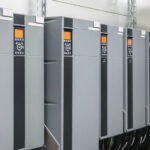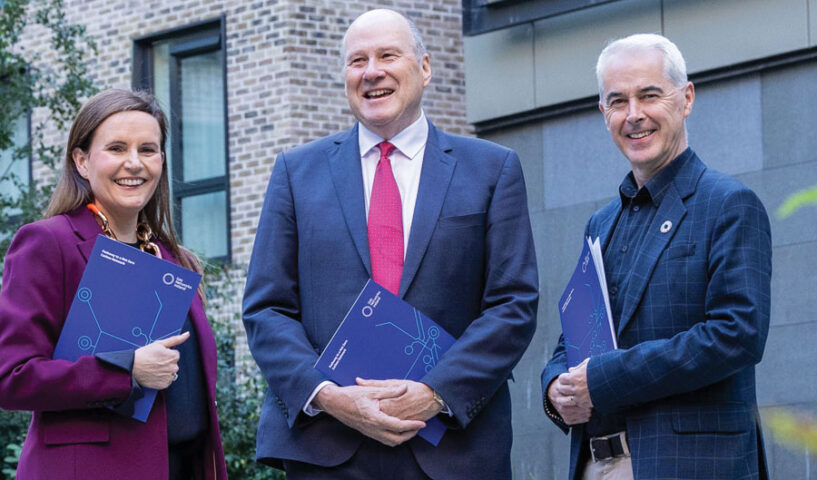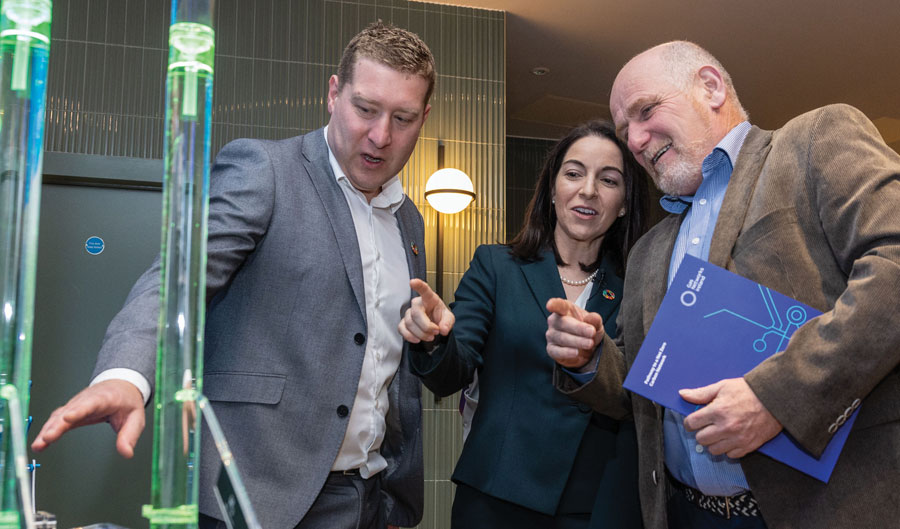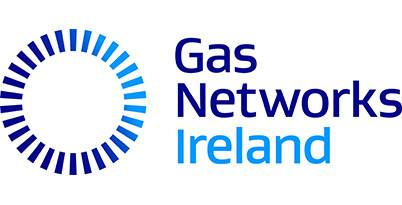
Government outlines electricity storage future
7th October 2024
Grant continues to advance innovative heating solutions
4th October 2024Pathway to Ireland’s renewable gas network

Pictured at the launch of Gas Networks Ireland’s Pathway to a Net Zero Carbon Network which outlines how the national gas network can transport 100 per cent renewable gas by 2045, were Gas Networks Ireland's Director of Strategy and Innovation, Edwina Nyhan; Chief Executive Officer, Cathal Marley (right); and broadcaster and former Minister for Agriculture, Ivan Yates.
Ireland is on the cusp of a significant energy transition, driven by the need to decarbonise and meet ambitious climate targets.
Central to this transition is the integration of renewable gases like biomethane and green hydrogen. Gas Networks Ireland is leading the charge, preparing its infrastructure and exploring innovative solutions to increase the volumes of biomethane and incorporate hydrogen into the national network.
With an ambitious plan to fully decarbonise Ireland’s gas infrastructure by 2045, Gas Networks Ireland is laying the groundwork for a future that supports 100 per cent renewable gases – efforts that are central to the company’s Pathway to a Net Zero Carbon Network strategy, which outlines a pathway to repurpose the existing gas network to transport renewable gases exclusively.
Biomethane: A key component of today’s renewable gas network
Currently, Gas Networks Ireland’s focus is on scaling up the use of biomethane — a carbon neutral, renewable gas made from organic waste. Over the past few years, Gas Networks Ireland has made great strides in integrating biomethane into the national grid. Domestically produced biomethane has already started replacing natural gas, proving its potential to decarbonise sectors such as heating, industry and transport.
Biomethane offers a significant opportunity for Ireland, particularly given its agricultural resources. The European Commission has identified Ireland as having the highest potential per capita for biomethane production in Europe. Leveraging this resource will not only help meet climate targets but also provide new income streams for rural communities and strengthen Ireland’s energy security.
In April 2024, Gas Networks Ireland made a significant move by connecting Bord na Móna’s Edenderry Renewable Energy Complex to the national gas network. This project will allow renewable gas, including biomethane, to be integrated into the fuel mix, leading to an estimated 40 per cent reduction in CO2 emissions at the facility. Similarly, an agreement with Irish Tar & Bitumen Suppliers Ltd. will replace 5 per cent of the company’s fuel usage with low-carbon gases, cutting emissions by approximately 30 per cent.
May 2024 saw the signing of a landmark contract with Bia Energy, which will inject biomethane from their €60 million anaerobic digestion (AD) plant in Huntstown directly into the national gas network. This project marks a significant milestone in the scale of biomethane production and integration in Ireland. In June 2024, Gas Networks Ireland supported the opening of the Republic of Ireland’s first dedicated BioCNG refuelling station in north Dublin, capable of cutting over 9,000 tonnes of CO2 emissions per year compared to diesel-powered HGVs.
These actions are all part of the foundation phase of Gas Networks Ireland’s pathway to a net zero gas network, setting the stage for much greater volumes of renewable gas in the years to come.
Ireland’s biomethane ambitions
The Government’s National Biomethane Strategy has set a target of producing 5.7 TWh of biomethane by 2030, but market interest suggests that this number could be much higher. According to Gas Networks Ireland, based on the 176 expressions of interest from potential biomethane producers received, the actual potential could be between 14 and 15 TWh — almost triple the current target.
Although it does not produce gas itself, Gas Networks Ireland plays an integral role in facilitating this growth by ensuring the gas network is prepared to accommodate higher volumes of biomethane, which is crucial for scaling up renewable gas production and injection capabilities.
To support this, Gas Networks Ireland is developing a Central Grid Injection (CGI) facility in Mitchelstown, County Cork, which will be a cornerstone of Ireland’s renewable gas infrastructure. Set to enter construction by the end of 2024, this facility will inject up to 700 GWh of renewable gas into the national network annually, contributing to 12 per cent of Ireland’s 2030 biomethane production target and reducing national CO2 emissions by 130,000 tonnes per year.
Gas Networks Ireland also launched a market sounding exercise, publishing a Prior Information Notice (PIN) on
e-tenders to gauge interest in supplying biomethane. This will help assess the potential for buying biomethane directly, a first for Gas Networks Ireland, allowing the utility to align with market opportunities and regulatory frameworks in support of Ireland’s biomethane ambitions.
Green hydrogen: The long term vision
While biomethane is the renewable gas of today, green hydrogen is the long term vision for decarbonising sectors that are difficult to electrify, such as heavy industry and high heat applications. Green hydrogen is produced by splitting water molecules using electricity from renewable sources like offshore wind. This process, known as electrolysis, generates hydrogen that can be stored and later used in power generation, transportation and industrial processes without emitting carbon dioxide.
However, hydrogen production at scale is still a few years away in Ireland. According to Gas Networks Ireland producing hydrogen at scale requires a lot of offshore wind power. The future of hydrogen in Ireland is intrinsically tied to the development of offshore wind farms, which will provide the necessary renewable electricity for large scale hydrogen production. This process will likely take time, but Gas Networks Ireland is already preparing for the future by ensuring its network is hydrogen-ready.

Pictured at the Gas Networks Ireland breakfast briefing on its ambitious Pathway to a Net Zero Carbon Network which outlines how the national gas network can transport 100 per cent renewable gas by 2045, were Gas Networks Ireland’s Hydrogen Technical Manager, Wayne Mullins, showing a demo model of Hydrogen generation through electrolysis to Chief Executive, Hydrogen Ireland, Paul McCormack; and Head of Customer Care and Communications, Gas Networks Ireland, Kate Gannon.
Gas Networks Ireland’s pathway to a net zero carbon gas network expects hydrogen volumes to make up 4 per cent of gas on Ireland’s network by 2032 (1.3 TwH hydrogen of total forecast volume demand of 32 TwH); and by 2045 hydrogen to make up over 68 per cent of all gas on Ireland’s network (30.1 TwH hydrogen of total forecast volume demand of 44.1TwH).
Preparing the gas network for hydrogen
One of the most significant challenges in integrating hydrogen into Ireland’s energy system is ensuring that the existing gas infrastructure can safely transport this new fuel. Hydrogen molecules are much smaller than natural gas, which raises concerns about material compatibility within the pipeline network.
Ireland with its modern gas network, is ahead of many European countries in this regard. Gas Networks Ireland is conducting extensive testing in partnership with academic institutions like the University College Dublin Energy Institute to ensure that the network can handle hydrogen blends. Their research has found that most domestic appliances, such as boilers, and industrial equipment can operate safely with up to 20 per cent hydrogen blended into natural gas, without requiring retrofitting.
This 20 per cent blend of hydrogen and natural gas is seen as a transitional step while green hydrogen production ramps up. Gas Networks Ireland is also preparing its two subsea interconnectors, which import 77 per cent of Ireland’s natural gas from the UK, to carry hydrogen blends. The expectation is that Britain, which is moving faster in hydrogen development, will begin blending hydrogen into its gas network in the next five years. As such, the first hydrogen to flow into Ireland may well come via these interconnectors, with Gas Networks Ireland ensuring the network can carry up to 2 per cent hydrogen.
Repurposing gas infrastructure for hydrogen
Gas Networks Ireland plans to repurpose existing natural gas infrastructure for the transportation of hydrogen. According to industry estimates, repurposing gas pipelines to carry hydrogen could cost just 10 to 35 per cent of what it would take to build new hydrogen pipelines from scratch. This approach is not only cost effective but also leverages Ireland’s existing assets to accelerate the transition to renewable gases.
Hydrogen’s role in Ireland’s future energy mix
Green hydrogen has the potential to transform Ireland’s energy landscape. The EU predicts that by 2050, hydrogen could account for 14 per cent of Europe’s total energy consumption. In Ireland, hydrogen could play an even larger role, particularly in sectors that are hard to electrify.
By 2030, Ireland aims to have at least 2GW of green hydrogen capacity in development. Gas Networks Ireland’s vision includes a national hydrogen network that could eventually connect to the European Hydrogen Backbone, providing Ireland with opportunities to export surplus hydrogen to European markets.
For more information visit www.gasnetworks.ie

